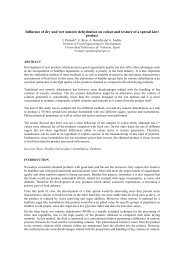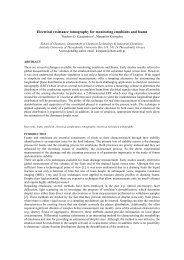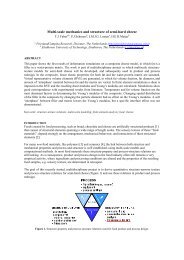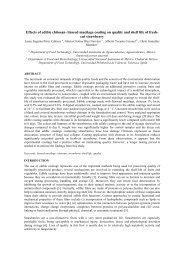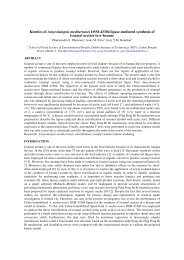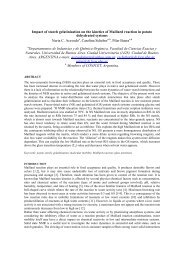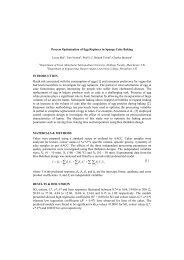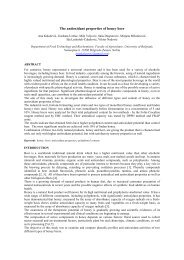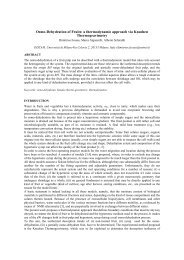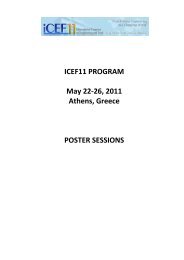Cereal Bar Development Using Exotic Fruit - 6 pages
Cereal Bar Development Using Exotic Fruit - 6 pages
Cereal Bar Development Using Exotic Fruit - 6 pages
You also want an ePaper? Increase the reach of your titles
YUMPU automatically turns print PDFs into web optimized ePapers that Google loves.
ownish - yellow, representing 9.56% of total fruit pulp and 73.81%, with very characteristic odor strong,<br />
sweet taste, acidic, involving numerous flat seeds (16.63%) [10]. The jack fruit is the largest tree-borne in the<br />
world, contend 8-15% of the fruit weight is seed. The seeds are 1.90 to 3.81 cm long and 1.27 to 1.90 cm<br />
thick and are rich in carbohydrate and fiber [11].<br />
The goal of this research is obtained cereal bars using exotic fruit (jenipapo and jack fruit seeds) in different<br />
composition and compare sensorial and physic-chemically the cereal bars developed with standard and<br />
commercial formulations.<br />
MATERIALS & METHODS<br />
Materials: The jenipapo pulp, jackfruit seed and all the raw materials to produce the cereal bars was<br />
purchased of local market from Aracaju-Sergipe, Brazil. The fruit and seed were sanitized with sodium<br />
hypochlorite, washed and drained. The jenipapo was dried at 50 o C for 6h and jackfruit was cooked for 70<br />
min. The chemicals were acquired from Labsynth (Brazil) and had analytical grade.<br />
<strong>Cereal</strong> bar formulation: The cereal bars was formulated using dry raw material (bran of oat -35% and rice –<br />
15%) and agglutinative ingredients (glucose syrup – 25% and honey – 25). The exotic fruit was added to the<br />
base formulation at different incorporation percentages. The agglutinative ingredients were heated to 95 o C<br />
and added to the dry ingredients, and then the bars were molded (9x3x1, 5cm) and cooled to -20 o C for 10<br />
min, packaged in aluminum and stored in a cool dry place at 25 o C.<br />
Centesimal composition: The cereal bars were evaluated for their physical-chemistry characteristics, in<br />
triplicate (n=3). The crude protein as N x 6.25 was determined by the Kjedahl method total lipids was<br />
analyzed by the Soxhlet method, ash was evaluated by burning the sample at 550 o C, total dietary fiber was<br />
determined of Wood method, moisture was analyzed in an oven at 105 o C until constant weight [12]. The<br />
water activity (aw) was measured using a hygrometer (Aqualab, Decagon 3TE). Carbohydrate were calculated<br />
by the difference method (100-water-protein-lipid-ash-fiber) and energy values (cal) were evaluated applying<br />
the factor 4, 9 and 4 for each gram of protein, lipid and carbohydrate, respectively [13].<br />
Texture analysis: After 4 days of storage, the hardness and crispness were determined using a texture<br />
analyzer (Stable Micro System, TA.XT2), coupled with the Software Texture Expert with probe TA-45, the<br />
test velocity was 1mm.s -1 and the distance between probe and sample was 8mm. Analyses were performed in<br />
triplicate on two points, one at the end and one in the middle of the bar.<br />
Sensorial evaluation: A panel of 60 consumers recruited from faculty, staff and students at the Tiradentes<br />
University. Criteria for selection were that panelists were between 18 and 60 years of age and regular<br />
consumers of cereal bars and not allergic to any raw material used. Panelists were instructed to evaluate the<br />
sensorial attributes such as appearance, taste, flavor, texture and overall linking. A 9-point hedonic scale with<br />
1= dislike extremely, 5= neither like nor like dislike and 9= like extremely was used [14].<br />
Statistical analysis: Sensory data were analyzed using the Statistical Analysis System (SAS Institute Inc.,<br />
Cary, NC, USA, 1995). Significance mean values were separated using the Least Significant Difference<br />
(LSD) test. The variance analyze (ANOVA) was evaluated by detect significance difference (p < 0.05)<br />
among the samples. The standard deviation of carbohydrate and energy values was obtained to error<br />
propagation.<br />
RESULTS & DISCUSSIO<br />
The cereal bars were formulated with jenipapo and jack fruit seeds in different concentration (5, 10 and 15%)<br />
and evaluated by sensorial analyze of acceptability. The notes of attributes sensorial to cereal bars with<br />
jenipapo and jack fruit seeds were shown in Table 1 and 2, respectively. The scores decreased with<br />
increasing the incorporation of jenipapo from approximately 7.0 (like moderately) to 5 (neither liked nor<br />
disliked). Statistical analysis showed that the cereal bars with 5% of jenipapo were different from those<br />
containing 10% and 15%, which were statistically similar (p ≤ 0.05) among themselves. It was also observed<br />
that all cereal bars formulated with jack fruit seeds did not differ significantly (p < 0.05) for all sensory<br />
parameters analyzed. In most cases, the notes for the sensory attributes were approximately 7.0 (like<br />
moderate). Thus, the formulations with 15% of jack fruit seeds and 5% of jenipapo were chosen to compare<br />
the sensorial, physico-chemical and texture characteristics among cereal bars standard, commercial and<br />
formulated with exotic fruits.



